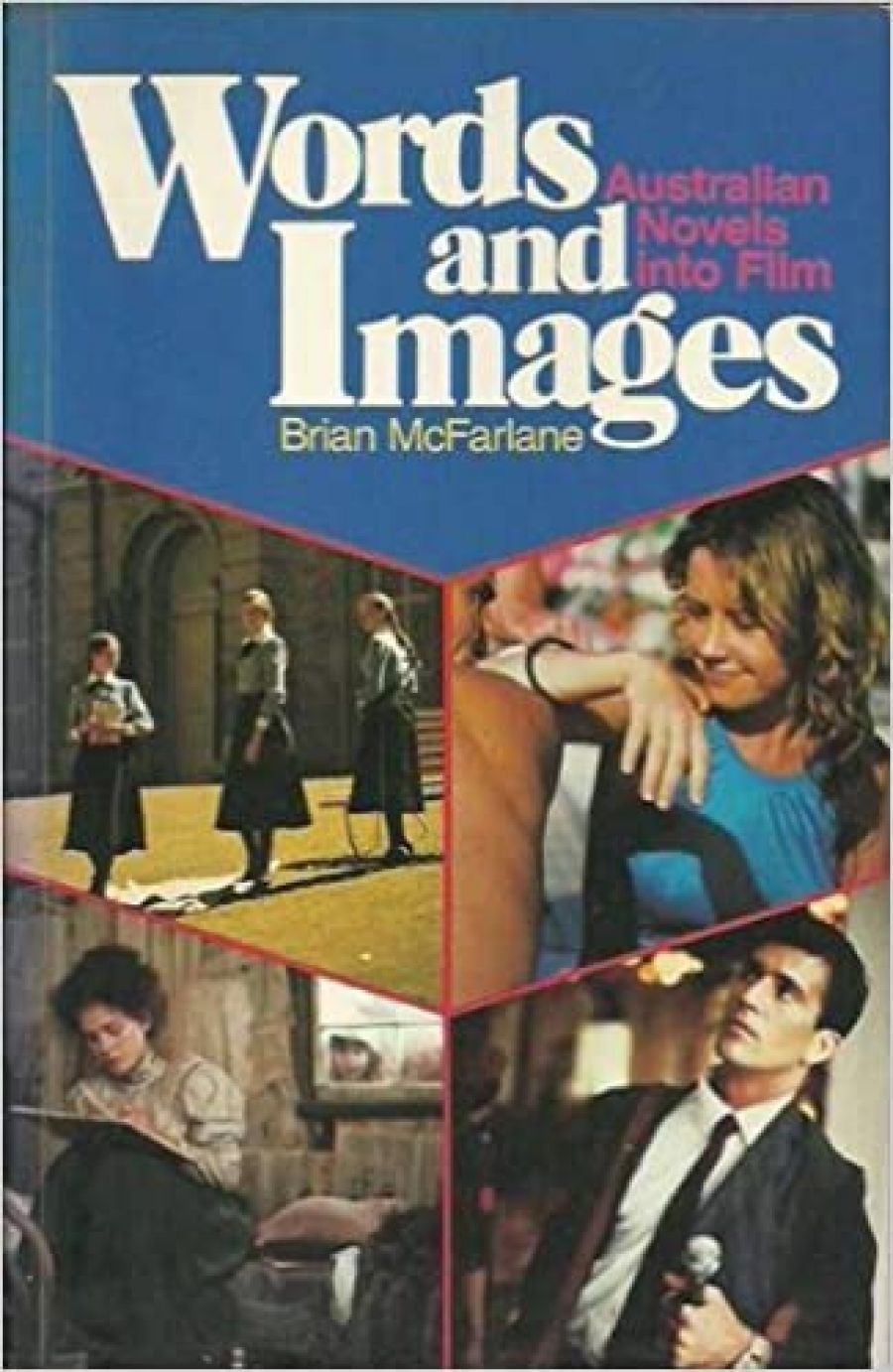
- Free Article: No
- Contents Category: Film
- Review Article: Yes
- Online Only: No
- Custom Highlight Text:
Words and Images is a valuable contribution to the rapidly growing body of work on Australian film culture and a welcome addition to the relatively small collection of volumes dealing with the film-literature connection. As McFarlane notes there is not, as yet, a ‘definitive work’ on the art of adaptation, though George Bluestone’s Novels into Film (1957) established a fairly solid base for others working in this area. McFarlane’s acknowledged indebtedness to Bluestone is most evident in the method he adopts in order to examine individual adaptations. Essentially it is one of determining and exploring changes to texts, that is, the major alterations and manipulations which take place in the process of adapting a narrative from one medium to another.
- Book 1 Title: Words and Images
- Book 1 Subtitle: Australian novels into film
- Book 1 Biblio: 'Brian Mcfarlane
Like Bluestone, McFarlane claims that the success, or otherwise, of any cinematic adaptation is much less to do with fidelity to the source than it is with the achievement of a separate artistic entity, which draws on what is most inspiring in the original text. In his discussion of Australian adaptations McFarlane is concerned to determine whether or not the film versions succeed in ‘finding their own centres of interest’, which may or may not be the central concerns of the works on which they are based, but which will almost certainly be established through very different narrative and linguistic means.
From the numerous Australian film adaptations of original works of fiction made in the last thirteen or so years, McFarlane has selected nine feature films and two television series for discussion. It is a selection which includes both books and films of considerable merit.
In some cases the author has developed comparisons made in his previously published reviews and articles. The chapter dealing with The Getting of Wisdom is a particularly satisfying expansion of his, to my mind, accurate assessment of the reasons why the film version of Richardson’s novel ‘becomes a film of incidental pleasures, fatally lacking an essence of its own’.
Elsewhere McFarlane has significantly modified his initial readings. The chapter on Monkey Grip is among the most impressive in the book because it demonstrates the author’s commitment to grappling with the difficulties presented by that novel’s unconventional narrative structure, and his critical flexibility in recognising that Monkey Grip has substantially more to recommend it than he had initially grasped (see Cinema Papers, August, 1982).
Other chapters too (notably those on Picnic at Hanging Rock, The Year of Living Dangerously and The Chant of Jimmie Blacksmith) offer new insights into the adaptations they discuss and provide evidence of McFarlane’s considerable abilities as both literary and film critic. Moreover they testify to his claim that ‘it is of course fascinating to consider how particular novels have been transposed to the screen; a close study of the processes can throw new light on both book and film’.
However the lengthy chapter on television adaptations of Martin Boyd’s Lucinda Brayford and Outbreak of Love is more puzzling. Its inclusion on the grounds that ‘Boyd is the only major Australian novelist so far ignored by filmmakers’ (several other names spring to mind; Christina Stead seems to me to be an infinitely more notable omission than Boyd) is not only arbitrary but also demands a more searching examination of the differences between television and film than McFarlane supplies. The relevance of these television adaptations to the issues raised elsewhere in Words and Images remains unclear.
The discussion of Lucinda Brayford and Outbreak of Love is the final chapter in the volume. Its position makes the inadequacies of McFarlane’s Boyd material more pronounced than they might otherwise have been. The lack of a substantial summary or concluding chapter is the book’s major flaw, one which indicates a failure to find a generalised perspective on the practice of adaptation. While the nature of the film-literature connection, and the diversity of the works under discussion pose problems for any attempt to construct a central line of argument which arrives at hard and fast conclusions, some recapitulation of significant points to emerge from individual comparative studies which have added substance to this book.
Words and Images, like Bluestone’s Novels into Film, cannot overcome the difficulties inherent in the method of dealing with adaptations on an individual basis. Though this method certainly suggest some new perspectives on the texts, ultimately it offers few clues to the nature of the processes involved in transposing words of fiction to the screen.
It would appear that new approaches to the area are required and they may well have to take into account a greater part of the relatively recent body of work on cinema theory than McFarlane attempts to deal with. They may also have to pay closer scrutiny to the very great pressures which the tyranny of the box office and film financing arrangements place on filmmakers.
The opportunities for work on adaptation in Australian literary and film culture are on the increase, as even a cursory glance at recent releases shows (Careful He Might Hear You, Dusty, for example). It is to be hoped that the publication of Words and Images marks the beginning of a new kind of discourse on narrative in an Australian context. Brian McFarlane’s work very capably lays some critical foundations for what is a potentially rich area of inquiry.


Comments powered by CComment